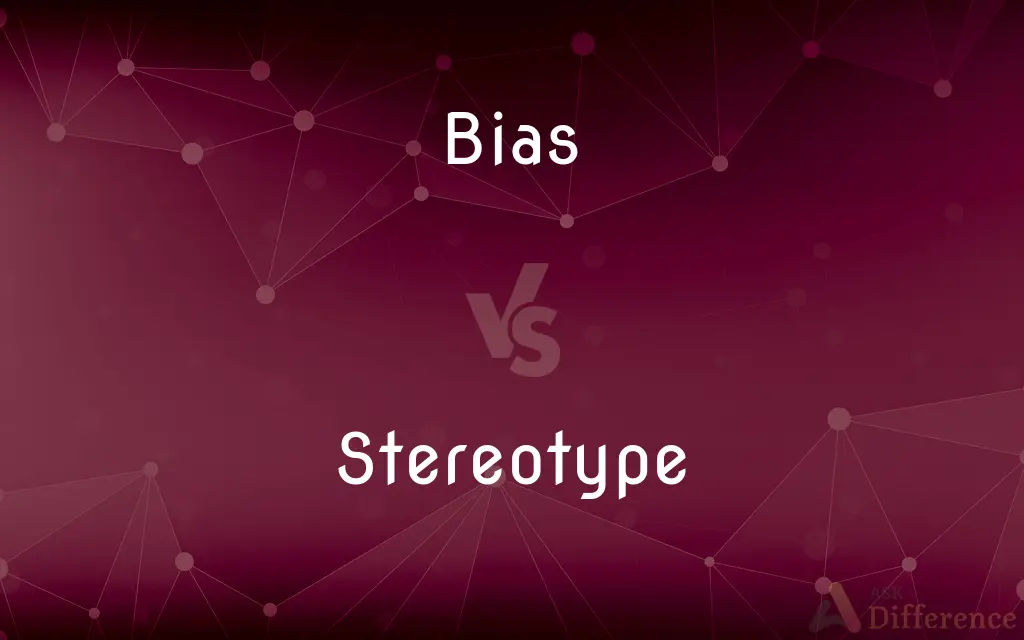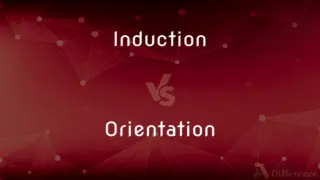Bias vs. Stereotype — What's the Difference?
By Tayyaba Rehman — Updated on September 22, 2023
Bias is a personal and often unreasoned judgment, while a stereotype is a widely held, oversimplified belief about a particular group.

Difference Between Bias and Stereotype
Table of Contents
ADVERTISEMENT
Key Differences
Bias and stereotype, both prevalent in human cognition and behavior, influence our perceptions and interactions. Bias is essentially a predisposition or inclination towards a particular person, group, or idea, whether positive or negative. It's a lens through which we see the world, sometimes rooted in our upbringing, experiences, or beliefs. On the other hand, stereotypes are generalizations, often oversimplified, about a group based on their perceived traits or behaviors.
While both bias and stereotype can affect judgments, their origins differ. Biases often arise from personal experiences or emotional responses. A person might harbor a bias because of a past encounter or upbringing. Stereotypes, however, typically emerge from societal beliefs, cultural norms, or media portrayals. They categorize people into groups based on certain characteristics, disregarding individual differences.
It's important to note that while biases are personal attitudes or beliefs about someone or something, stereotypes are often collective beliefs that people have about a group. For instance, a person might hold a bias against a particular coworker due to past disagreements, but that same person might stereotype an entire profession based on what they've heard or seen.
Both bias and stereotype can lead to prejudice and discrimination. They might cause individuals to treat others unfairly or jump to conclusions without evidence. Recognizing and challenging both biases and stereotypes is essential to promote understanding and acceptance in diverse societies.
Comparison Chart
Definition
Personal and often unreasoned judgment.
Widely held, oversimplified belief about a particular group.
ADVERTISEMENT
Origin
Personal experiences, upbringing, or emotions.
Societal beliefs, cultural norms, media portrayals.
Application
Individual attitude or belief about someone/something.
Collective beliefs about a group.
Specificity
Can be towards a single entity or a group.
Always about a group.
Potential Consequences
Can lead to individual unfair treatment or decisions.
Can lead to group-based discrimination or misconceptions.
Compare with Definitions
Bias
A personal preference or prejudice in favor or against.
Her bias against modern art prevented her from appreciating the exhibit.
Stereotype
A generalization applied to every person in a group.
The stereotype that all teenagers are rebellious is unfounded.
Bias
An inclination swaying objective judgment.
The judge's bias was evident in his unfair rulings.
Stereotype
An oversimplified belief about a particular group.
The movie perpetuated the stereotype of the clueless tourist.
Bias
A systematic error introduced into results.
The faulty equipment introduced a bias into the experiment.
Stereotype
A standardized conception held in common by members of a group.
She challenged the cultural stereotype tied to her heritage.
Bias
Bias is a disproportionate weight in favor of or against an idea or thing, usually in a way that is closed-minded, prejudicial, or unfair. Biases can be innate or learned.
Stereotype
A fixed or conventional notion about a category of people.
The stereotype of the 'nerdy' scientist is often seen in media.
Bias
A line going diagonally across the grain of fabric
Cut the cloth on the bias.
Stereotype
In social psychology, a stereotype is a generalized belief about a particular category of people. It is an expectation that people might have about every person of a particular group.
Bias
A preference or an inclination, especially one that inhibits impartial judgment.
Stereotype
A widely held but fixed and oversimplified image or idea of a particular type of person or thing
Sexual and racial stereotypes
The stereotype of the woman as the carer
Bias
An unfair act or policy stemming from prejudice.
Stereotype
A relief printing plate cast in a mould made from composed type or an original plate.
Bias
A statistical sampling or testing error caused by systematically favoring some outcomes over others.
Stereotype
View or represent as a stereotype
The city is too easily stereotyped as an industrial wasteland
Bias
A weight or irregularity in a ball that causes it to swerve, as in lawn bowling.
Stereotype
A conventional, formulaic, and oversimplified conception, opinion, or image.
Bias
The tendency of such a ball to swerve.
Stereotype
One that is regarded as embodying or conforming to a set image or type.
Bias
The fixed voltage applied to an electrode.
Stereotype
(Printing) A metal printing plate cast from a matrix molded from a raised printing surface, such as type.
Bias
Slanting or diagonal; oblique
A bias fold.
Stereotype
To make a stereotype of.
Bias
To influence in a particular, typically unfair direction.
Stereotype
To characterize by a stereotype
"Elderly Americans are the neglected sector of the fashion industry, stereotyped by blue hair and polyester pantsuits" (American Demographics).
Bias
To apply a small voltage to (a grid).
Stereotype
To give a fixed, unvarying form to.
Bias
Inclination towards something.
Stereotype
To print from a stereotype.
Bias
The diagonal line between warp and weft in a woven fabric.
Stereotype
A conventional, formulaic, and often oversimplified or exaggerated conception, opinion, or image of (a person or a group of people).
Bias
A wedge-shaped piece of cloth taken out of a garment (such as the waist of a dress) to diminish its circumference.
Stereotype
(psychology) A person who is regarded as embodying or conforming to a set image or type.
Bias
(electronics) A voltage or current applied to an electronic device, such as a transistor electrode, to move its operating point to a desired part of its transfer function.
Stereotype
(printing) A metal printing plate cast from a matrix moulded from a raised printing surface.
Bias
(statistics) The difference between the expectation of the sample estimator and the true population value, which reduces the representativeness of the estimator by systematically distorting it.
Stereotype
(software engineering) An extensibility mechanism of the Unified Modeling Language, allowing a new element to be derived from an existing one with added specializations.
Bias
(sports) In the games of crown green bowls and lawn bowls: a weight added to one side of a bowl so that as it rolls, it will follow a curved rather than a straight path; the oblique line followed by such a bowl; the lopsided shape or structure of such a bowl. In lawn bowls, the curved course is caused only by the shape of the bowl. The use of weights is prohibited.
Stereotype
(transitive) To make a stereotype of someone or something, or characterize someone by a stereotype.
Bias
(South Korean idol fandom) A person's favourite member of a K-pop band.
Stereotype
To prepare for printing in stereotype; to produce stereotype plates of.
To stereotype the Bible
Bias
(transitive) To place bias upon; to influence.
Our prejudices bias our views.
Stereotype
To print from a stereotype.
Bias
(electronics) To give a bias to.
Stereotype
To make firm or permanent; to fix.
Bias
Inclined to one side; swelled on one side.
Stereotype
A plate forming an exact faximile of a page of type or of an engraving, used in printing books, etc.; specifically, a plate with type-metal face, used for printing.
Bias
Cut slanting or diagonally, as cloth.
Stereotype
The art or process of making such plates, or of executing work by means of them.
Bias
In a slanting manner; crosswise; obliquely; diagonally.
To cut cloth bias
Stereotype
To prepare for printing in stereotype; to make the stereotype plates of; as, to stereotype the Bible.
Bias
A weight on the side of the ball used in the game of bowls, or a tendency imparted to the ball, which turns it from a straight line.
Being ignorant that there is a concealed bias within the spheroid, which will . . . swerve away.
Stereotype
Fig.: To make firm or permanent; to fix.
Powerful causes tending to stereotype and aggravate the poverty of old conditions.
Bias
A leaning of the mind; propensity or prepossession toward an object or view, not leaving the mind indifferent; bent; inclination.
Strong love is a bias upon the thoughts.
Morality influences men's lives, and gives a bias to all their actions.
Stereotype
A conventional or formulaic conception or image;
Regional stereotypes have been part of America since its founding
Bias
A wedge-shaped piece of cloth taken out of a garment (as the waist of a dress) to diminish its circumference.
Stereotype
Treat or classify according to a mental stereotype;
I was stereotyped as a lazy Southern European
Bias
A slant; a diagonal; as, to cut cloth on the bias.
Stereotype
A preconceived idea ignoring individual differences.
Stereotypes about gender roles can limit opportunities.
Bias
Inclined to one side; swelled on one side.
Bias
Cut slanting or diagonally, as cloth.
Bias
In a slanting manner; crosswise; obliquely; diagonally; as, to cut cloth bias.
Bias
To incline to one side; to give a particular direction to; to influence; to prejudice; to prepossess.
Me it had not biased in the one direction, nor should it have biased any just critic in the counter direction.
Bias
A partiality that prevents objective consideration of an issue or situation
Bias
A line or cut across a fabric that is not at right angles to a side of the fabric
Bias
Influence in an unfair way;
You are biasing my choice by telling me yours
Bias
Cause to be biased
Bias
Slanting diagonally across the grain of a fabric;
A bias fold
Bias
A tendency to favor a particular outcome or view.
The researcher's bias impacted the study's findings.
Bias
An unfair inclination against someone or something.
His bias against technology made him reject new solutions.
Common Curiosities
Can biases be unconscious?
Yes, there are unconscious or implicit biases that individuals may not be aware of.
How are stereotypes formed?
Stereotypes can form from cultural norms, media portrayals, or passed-down beliefs.
Why are stereotypes harmful?
Stereotypes can lead to misconceptions, prejudices, and discriminatory behaviors.
Are all biases negative?
No, biases can be positive, negative, or neutral.
Can one recognize their own bias?
With introspection and self-awareness, one can recognize and challenge their biases.
Are stereotypes based on facts?
They may be based on partial truths but are generalized and often don't reflect the whole picture.
Are stereotypes always inaccurate?
While stereotypes may contain elements of truth, they are oversimplified and don't account for individual differences.
Are stereotypes only about people?
While often about people, stereotypes can also be about places, things, or ideas.
Do biases affect decision-making?
Yes, biases can influence decisions, often leading to unfair or incorrect outcomes.
Is everyone biased?
All individuals have biases, but the nature and degree vary.
Do stereotypes change over time?
Yes, as societies evolve, stereotypes can change, diminish, or new ones can form.
How does bias differ from opinion?
While both are personal beliefs, biases are often deeper-rooted and may not be based on reason or evidence.
Can bias be eliminated?
While it's challenging to completely eliminate biases, awareness and education can help reduce them.
Share Your Discovery

Previous Comparison
Catholic vs. Protestant
Next Comparison
Induction vs. OrientationAuthor Spotlight
Written by
Tayyaba RehmanTayyaba Rehman is a distinguished writer, currently serving as a primary contributor to askdifference.com. As a researcher in semantics and etymology, Tayyaba's passion for the complexity of languages and their distinctions has found a perfect home on the platform. Tayyaba delves into the intricacies of language, distinguishing between commonly confused words and phrases, thereby providing clarity for readers worldwide.
















































